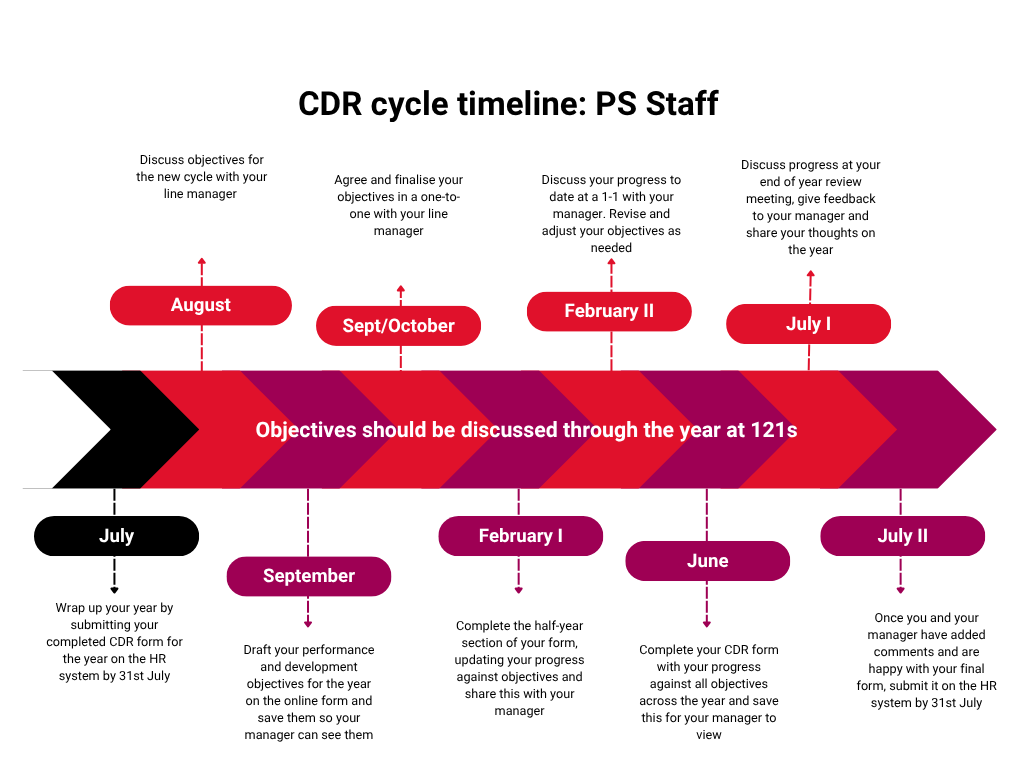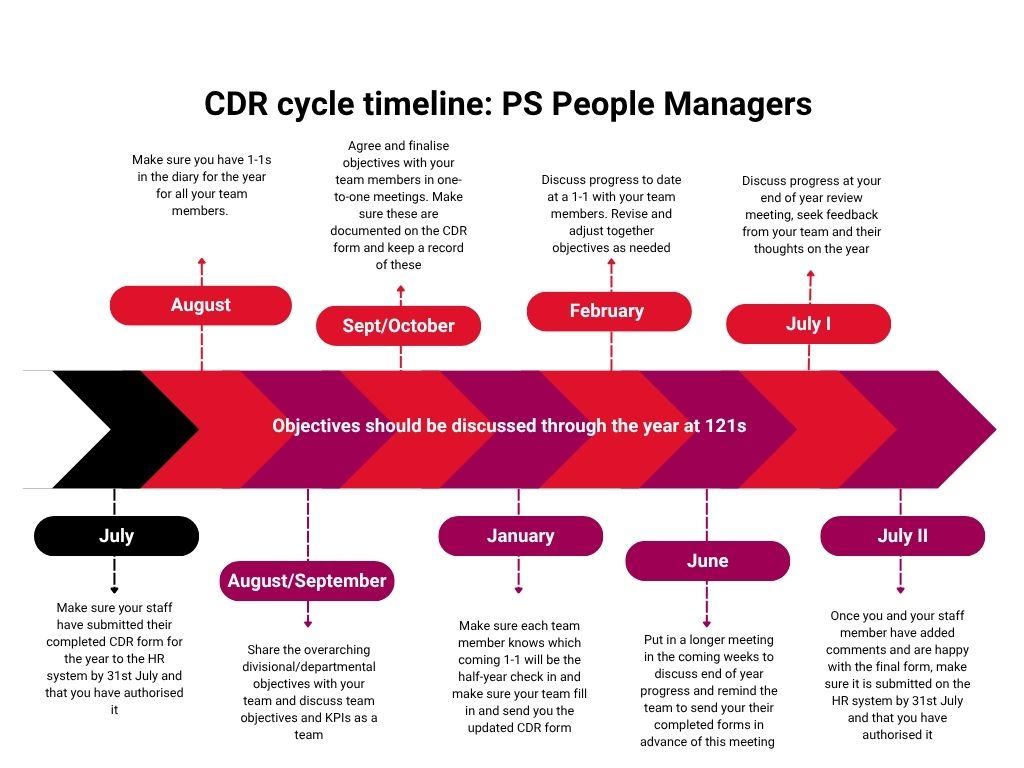What is the Career Development Review?
The Career Development Review Scheme (CDR) for professional services staff is a continuous process designed to allow you and your line manager to:
- Manage workload
- Ensure wellbeing and work-life balance
- Set objectives and performance standards
- Review progress
- Give and receive feedback
- Explore development needs
- Discuss career aspirations
What is included in the CDR process?
As a PS member of staff, the type of role that you do may influence the process across the year.
From November 2023, there are different version of the process and you should discuss and agree with your line manager which works better for you. The two versions are the standard version and the consolidated version.
The standard version will be appropriate for most people and is the version the School expects the majority of PS staff to complete, but if you work in a role where there is less variation year on year the consolidated version may be more appropriate to your role.
The standard version
The diagram below shows what your CDR will look like across the year and the actions you will need to take as part of your annual CDR cycle.

You can download this diagram here.
The CDR is made up of:
- Regular one-to-one catch-up meetings throughout the year.
- A one-to-one meeting in August/September each year to set manageable objectives.
- A half-year review meeting in February to check in and adjust objectives as necessary.
- A one-to-one meeting in June/July each year to review progress.
One-to-one meetings should be held throughout the year to share on-going feedback, explore progress and ideas, and allow for any unexpected matters to be identified and addressed. These sessions are, by their nature, less formal than the annual review meeting. The timescale for these will be as relevant to the role; however, they should be held at least once a month and we would advise holding these face-to-face as much as possible.
Remember that you can and should review and adjust objectives together as you progress. Some objectives will be completed more easily than others and some may become less relelvant as you repsond to changing needs and priorities over time.
As an LSE people manager, the diagram below shows the actions you will need to take across the annual CDR cycle to support your team in getting the best out of their CDRs.

You can download this diagram here.
How is CDR progress recorded?
For the 2024-25 Academic Year: We've provided a form to help you and your line manager record progress. You can edit and save the form as you work on it, before you finally submit it to your line manager. You should submit the form to your line manager at least a week before your end of year review meeting in June or July.
Ahead of the meeting, you may also choose to seek additional feedback from others. Organisational Learning can provide you with access to an online tool to collect anonymous feedback from colleagues, managers, leaders and other stakeholders relevant to your work. The tool will prvide you with a personalised report of your strengths and development areas. If you would like access to this tool, please contact us at hr.learning@lse.ac.uk
After the review meeting you should upload the completed progress form to MyHR.
For the 2025-26 Academic Year: The CDR objectives for the year 2025/26, will be submitted directly into MyHR. In the CDR toolkit you can find links to guidance on setting these objectives for the next CDR cycle. Please make sure that you and your team members take the time to set meaningful role and development objectives for the next academic year. The form will open on 28 July 2025 for staff to submit their objectives into MyHR.
A step by step guide on how to use the online system from the 2025/26 cycle can be found here.
Target setting
Targets in the form of objectives/performance standards are set as part of a face-to-face meeting for the beginning of the new Academic year in August/September as part of the School’s business planning process. Where an area’s annual operating cycle makes this particular timetable difficult to achieve, a revised timeframe should be agreed with that area’s HR Partner.
Targets can be a combination of either objectives and/or performance standards dependent on the individual’s role. These should always be specific, measurable statements of what is required within clear time frames. The acronym SMART is a useful guide for writing objectives/performance standards:
S–Specific
M–Measurable
A– Achievable
R– Relevant
T–Time bound
The total number of targets should be manageable and consider workloads- no more than 5 is a good guide.
They should clearly relate to LSE 2030 (the School’s strategy) and the business plan of the Division/Department/Centre.
Those in managerial roles should include targets about that part of their role (i.e., being a people manager).
One-to-ones
Regular catch-up sessions are a vital part of the CDR process. These should be held throughout the year with at least one face to face meeting a month. (Many team members will have more frequent virtual meetings throughout the month)
The format for these catch-ups can involve:
- Prioritising workloads and ensuring a good work/ life balance
- Supporting wellbeing and enabling people to deal with stress.
- Giving and receiving feedback
- Monitoring work and work performance
- Sharing information relevant to work
- Identifying learning and development needs
- People management (if relevant to the role)
When managed well they will enable the annual progress review to be simply a formal summary of these on-going discussions.
Learning and development
As part of the process, it is important to discuss whether any training and/or development would be beneficial. This should include:
- Any support required to achieve the objectives/performance standards set
- Immediate career development needs
- Broader career aspirations
- Personal development
All staff should be encouraged to develop a Personal Development Plan (PDP). You'll find space on the CDR form to do this.
The consolidated version
More details of this version of the process can be found here.
Not found the answer you're looking for?
Please contact hr.learning@lse.ac.uk if you have any further queries about the CDR process for professional services staff.